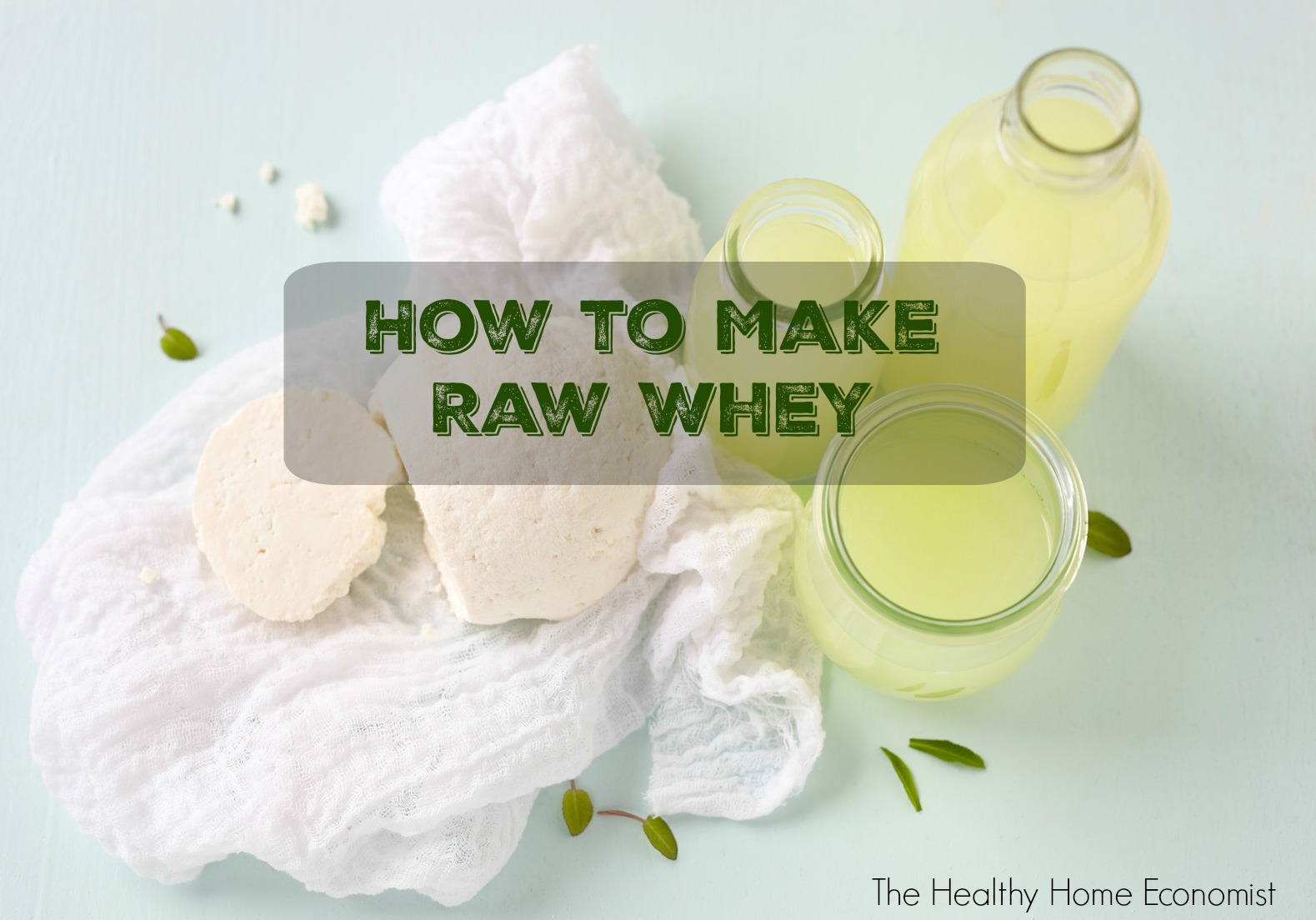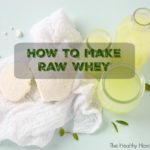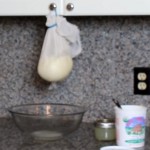How to make raw, enzyme and probiotic-rich liquid whey to use as a starter culture for all your home fermentation needs.

Do you know how to make whey from yogurt, kefir or raw milk?
A by-product of this simple technique is healthy homemade cream cheese that is loaded with enzymes and probiotics.
The recipe below describes how with visual instructions via video demonstration!
Making homemade baby formula? I recommend using this “quick whey” no straining method as the fastest and easiest approach.
How to Make Whey the REAL Way
Making real, liquid, nutrient rich, unadulterated whey in your own kitchen is a MUST step for any traditional cook to learn.
Without whey in its whole, liquid form, many other traditional recipes cannot even be attempted. You cannot buy whey from the store except in a denatured, unhealthy, powdered whey form. It is worth your time to learn what I show you in the video below.
Other video lessons on this blog show you how to use this whole food form of whey to make many delicious, healthful recipes for your family. Whey as made in the video demo below will keep up to 6 months in the refrigerator in a sealed mason jar.
If you absolutely have no access to farm fresh milk to make whole, unadulterated, enzyme rich whey, then you can use plain, organic yogurt brand from the store instead. Here are tips on how to spot the best yogurt brands.
The process is basically exactly the same thing as shown in the video.
You won’t get nearly as much whey using yogurt as clabbered, farm fresh milk, but at least you can get enough to get you started.
Wonderful Whey and REAL Cream Cheese
The raw, enzyme-rich cream cheese I make in the recipe video below is fantastic on a sprouted or sourdough bagel for breakfast. Don’t buy the Ezekiel sprouted muffins as they contain soy. This low-carb bagel recipe is another great one to try.
If you prefer to buy, these sourdough bagels are available for shipping freshly made to your door.
To make, just take your cream cheese left over from making liquid whey and add a few strawberries and a dash of dark maple syrup to taste. Mix together by pulsing a few times in your food processor. This wonderful, fresh, REAL strawberry cream cheese will last one to two weeks in the refrigerator. Another wonderful use for this healthy raw cheese is to make an easy no bake cheesecake.
No access to raw milk where you live? No problem. Check out this recipe plus video on how to separate whey from yogurt purchased from the store.
Cloudy Whey vs Clear Whey
No matter whether your whey turns out cloudy or clear, it is safe and fine to use in all your favorite recipes. This article explains why sometimes whey is cloudy compared to its usual golden color.

Raw Whey Recipe
How to separate raw, liquid whey from clabbered milk. The process also creates probiotic rich cream cheese.
Ingredients
- 1 quart raw milk preferably grassfed
- 1 large glass bowl
- 1 large rubber band
- 1 white dishtowel
Instructions
-
Allow the raw milk to sit on the counter for 1-3 days at room temperature.
-
When the milk separates into curds and whey (transforms into clabbered milk) you are ready to proceed. Note that the fresher the raw milk and the colder the temperature of your house, the longer it will take the raw milk to clabber.
-
Line a clean, large glass bowl with a clean, white dishtowel that isn’t too thick. Cheesecloth will also work, but the holes in the mesh must be very small, else the milk curds will pass through.
-
Gently pour the clabbered milk into the middle of the dish towel. Gather up the ends and fasten with a rubber band. Attach to a knob on an upper cabinet in your kitchen as shown in the picture.

-
Let the raw whey drip into the bowl underneath. This process will continue for an hour or two.
-
After the dripping stops, gently take down the hanging bag and place it into a clean bowl. Scrape out the raw cream cheese that is inside the bag, put in a container with a lid and refrigerate.
-
Pour the liquid whey from the dripping bowl into a glass mason jar, afix the lid and refrigerate.
-
Refrigerated, raw cream cheese will be good to eat for about a week. Raw whey will last several months refrigerated.
Recipe Video
How to Use Whey in Recipes
How to Make Ricotta Three Ways (plus Video How-to)
Perfect Probiotic Cottage Cheese
Cheese Making: Common Problems and Solutions








Hi Kelsey, I don't think goat milk clabbers like cow milk because it is naturally homogenized (the cream doesn't come to the top like cow's milk). I must say that I have never tried it myself to know for sure. I guess you've answered the question!
Hi Sarah! Question – how long is too long to have the milk clabbering on the counter? I put my raw milk on the counter on Sunday night, and here it is Thursday and it still doesn't seem to have clabbered. The milk was not quite sour when I put it on the counter and my house is a bit cool (I live in AK), but I'm worried about how long I've left it on the counter. It hasn't molded or anything. It is goat's milk, so maybe it won't clabber like cow's milk? I know you said you don't know if goat's milk can be separated into liquid whey and cheese, but I thought it would at least clabber, but maybe I'm wrong!
Hi Elizabeth, it should be fine. The cream cheese might be a bit strong in flavor for sitting out so long, but it will be fine to eat. Just add some maple syrup and strawberries and that should mask it pretty well.
Sarah –
Thank you so much for the video's I love having them as reference. I bought raw milk and set it out in a glass dish for the last 4 days. (we were sick some of those days so it got forgotten) When I found it today it was all thick and the top was more yellowish. It was not chunky at all just one big yellowish blob. I hung it up to drip but am wondering if it's okay?
Hi Shannon, it might be the cow, but not too sure about that .. are the holsteins grassfed? Sometimes if you use really really sour milk the cream cheese can be extremely strong tasting. I have had that happen to me also once or twice. Maybe try it with slightly soured milk next time and see if you can get some milk from a jersey or guernsey cow so the cream is really thick and rich.
Thanks Sarah. When I made this, I didn't try the cream cheese till later that day, and it was very….cow-ey. There is no other way to describe it…it tasted and smelled like a barn. The milk never does, it tastes delicious. I went ahead and tried to mask the taste with syrup and berries, but to no avail – had to dump the whole thing. What might I have done wrong? The whey smells bad to me too, but I don't plan on eating it alone so don't care. I felt like the cream cheese was a huge waste and I was so excited…could this be because of the type of cow, or is it my technique? Our milk comes from Holsteins.
Shannon
Hi Shannon, milky is fine. Sometimes it turns out more clear than other times. When you refrigerate, the white milky part will probably come to the top and the whey will get clearer. Then you can strain it off if you want to.
Hi Sarah!
I just attempted this for the first time (thank you SO much for the video – never had the courage to try it before!). My whey is not clear, it's milky looking – is that ok? Does it mean I needed to let the milk clabber for longer? There were big chunks when I poured it into the cloth/bowl, but I'm still not sure I've done this correctly.
Thanks!!
Shannon
on how clabbered the milk actually is. If it is really separated, then it doesn't take as long as if the milk is slightly clabbered.
Hi Stephanie,
Mix in some maple syrup and strawberries and it will taste delicious – great bagel spread! Putting it in the fridge didn't mess it up – you are just maybe not used to clabbered milk so much. There is no set time for it to drip – it just drips until you see that it is done. Much depends